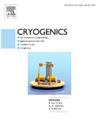Magnetocaloric effect in Gd8P2O17 and Gd3PO7
IF 2.1
3区 工程技术
Q3 PHYSICS, APPLIED
引用次数: 0
Abstract
The gadolinium-rich phosphates, Gd8P2O17 and Gd3PO7, were successfully synthesized by the high-temperature solid-phase reaction method. Gd8P2O17 and Gd3PO7 crystallize in the monoclinic system. Their magnetic and magnetocaloric properties were systematically investigated by measuring magnetic susceptibility (χ) and magnetization (M). The phase transition temperatures for Gd3PO7 and Gd8P2O17 were observed to be below 2 K. The max magnetic entropy change () of Gd8P2O17 reaches 21.7 J·kg−1 K−1 at 2 K and 5 T, which is comparable to that of the commercial Gd3Ga5O12 under the same conditions. Gd3PO7 exhibits a of 10.3 J·kg−1 K−1 at 6 K and 5 T, similar to the value of LiDyP4O12 under the same conditions. Moreover, the relative cooling capacity (RCP) and refrigeration capacity (RC) values reach 165.05 and 123.94 J/kg for Gd3PO7 and 152.14 and 108.99 J/kg for Gd8P2O17 under the magnetic field changes of 5 T. These results indicate that Gd8P2O17 and Gd3PO7 may be promising candidates for ultra-low temperature magnetic refrigeration applications.
Gd8P2O17和Gd3PO7的磁热效应
采用高温固相法成功合成了富钆磷酸盐Gd8P2O17和Gd3PO7。Gd8P2O17和Gd3PO7在单斜晶系中结晶。通过测量磁化率(χ)和磁化强度(M),系统地研究了它们的磁性和磁热学性能。Gd3PO7和Gd8P2O17的相变温度均低于2 K。Gd8P2O17在2k和5t下的最大磁熵变化(-ΔSMmax)达到21.7 J·kg−1 K−1,与同等条件下的商用Gd3Ga5O12相当。Gd3PO7在6 K和5 T下的光能-ΔSMmax为10.3 J·kg−1 K−1,与LiDyP4O12在相同条件下的光能相似。此外,在5 t磁场变化下,Gd3PO7的相对制冷量(RCP)和制冷量(RC)分别达到165.05和123.94 J/kg, Gd8P2O17的相对制冷量(RCP)和制冷量(RC)分别达到152.14和108.99 J/kg。这些结果表明,Gd8P2O17和Gd3PO7可能是超低温磁制冷应用的理想选择。
本文章由计算机程序翻译,如有差异,请以英文原文为准。
求助全文
约1分钟内获得全文
求助全文
来源期刊

Cryogenics
物理-热力学
CiteScore
3.80
自引率
9.50%
发文量
0
审稿时长
2.1 months
期刊介绍:
Cryogenics is the world''s leading journal focusing on all aspects of cryoengineering and cryogenics. Papers published in Cryogenics cover a wide variety of subjects in low temperature engineering and research. Among the areas covered are:
- Applications of superconductivity: magnets, electronics, devices
- Superconductors and their properties
- Properties of materials: metals, alloys, composites, polymers, insulations
- New applications of cryogenic technology to processes, devices, machinery
- Refrigeration and liquefaction technology
- Thermodynamics
- Fluid properties and fluid mechanics
- Heat transfer
- Thermometry and measurement science
- Cryogenics in medicine
- Cryoelectronics
 求助内容:
求助内容: 应助结果提醒方式:
应助结果提醒方式:


